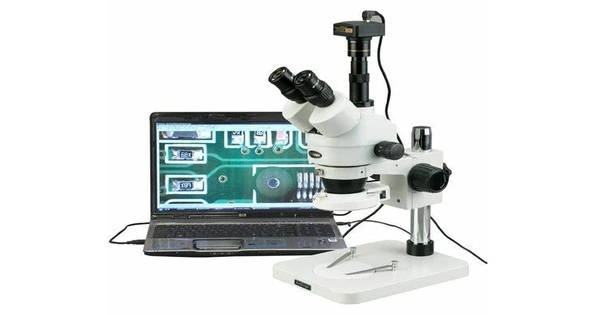A digital microscope is a more advanced optical microscope that uses digital technology to capture and display images. It is a type of optical microscope that uses optics and a digital camera to output an image to a monitor, sometimes using software that runs on a computer. Instead of directly viewing specimens through eyepieces, digital microscopes use cameras and electronic imaging sensors to capture high-resolution images that can then be displayed on a monitor or saved digitally for further analysis.
A digital microscope frequently has its own built-in LED light source and differs from an optical microscope in that it does not allow direct observation of the sample through an eyepiece. The entire system is designed for the monitor image because the image is focused on the digital circuit. Optics for the human eye are not included.
Here are some key features and advantages of digital microscopes:
- Digital Imaging: These microscopes capture images or videos of specimens in real-time. This digital format allows for easy storage, sharing, and analysis of the captured data.
- Magnification and Zoom: These microscopes often provide a range of magnification options, and some models offer digital zoom capabilities, allowing users to zoom in on specific areas of interest.
- Image Capture and Recording: Users can capture still images or record videos of specimens for documentation, analysis, or educational purposes. Some digital microscopes come with built-in memory or the option to save files to external storage devices.
- Measurement and Analysis Tools: Many digital microscopes include software that allows users to measure dimensions, annotate images, and perform various types of analysis on captured digital images.
- Live View and Real-time Monitoring: These microscopes frequently have a live view mode that allows users to view specimens on a computer monitor in real time. This feature is useful for teaching, presentations, and group projects.
- Portability: Some digital microscopes are small and portable, making them ideal for fieldwork or situations where traditional microscopes would be inconvenient.
- 3D Imaging: Certain digital microscopes can generate three-dimensional images of specimens, providing more depth and detail for analysis.
Digital microscopes frequently have user-friendly interfaces, allowing them to be used by a wide range of users, including students, educators, and researchers. These microscopes are used in a variety of fields such as biology, medicine, material science, forensics, and education. They outperform traditional optical microscopes in terms of documentation, analysis, and collaboration.
Digital microscopes range in price from low-cost USB digital microscopes to advanced industrial digital microscopes that cost tens of thousands of dollars. Low-cost commercial microscopes typically lack illumination optics (such as Köhler illumination and phase contrast illumination) and are more akin to webcams with a macro lens. A digital camera can be attached to an optical microscope.
















